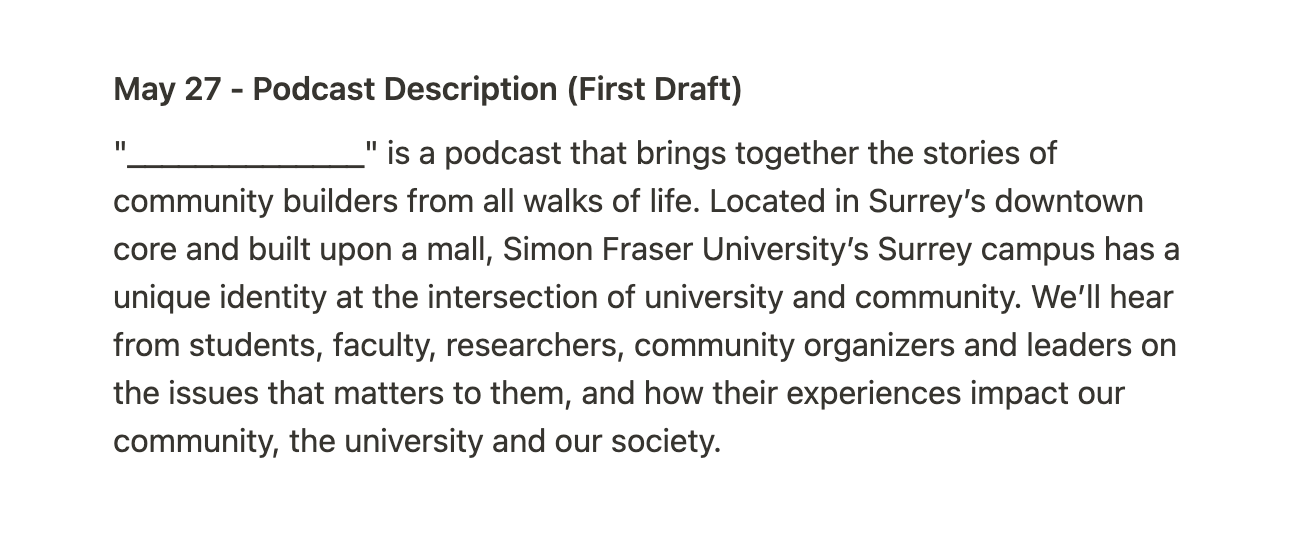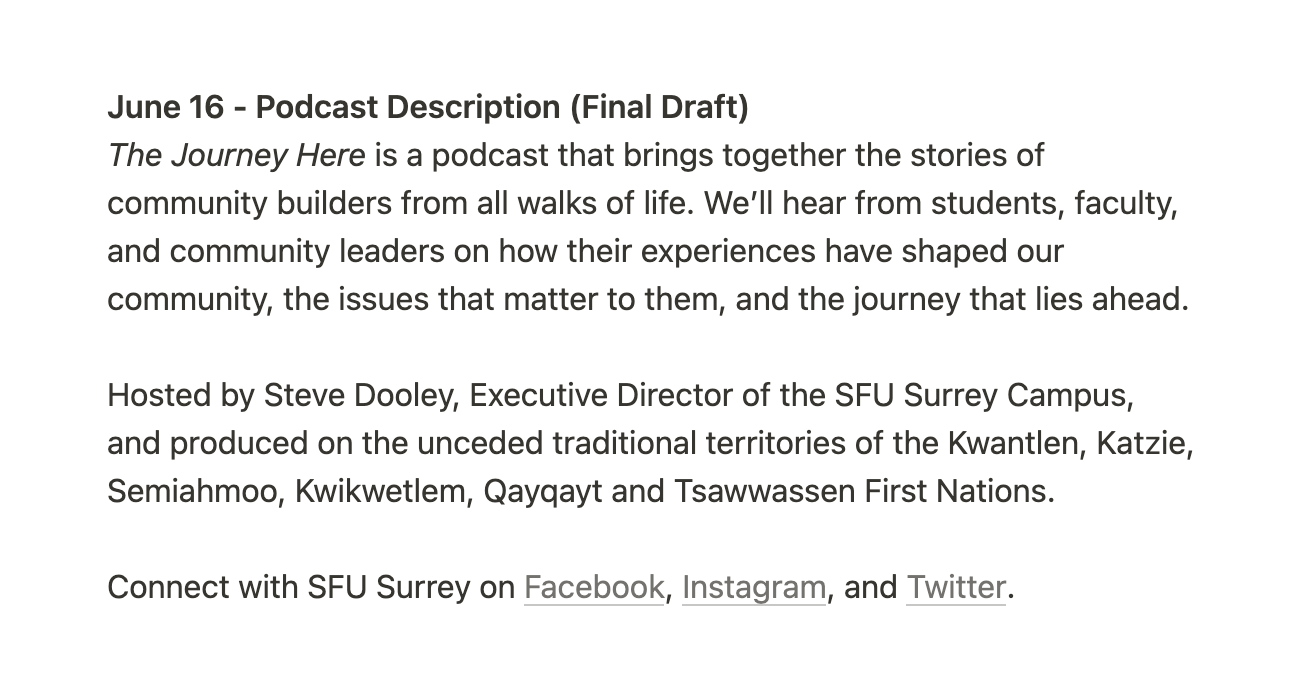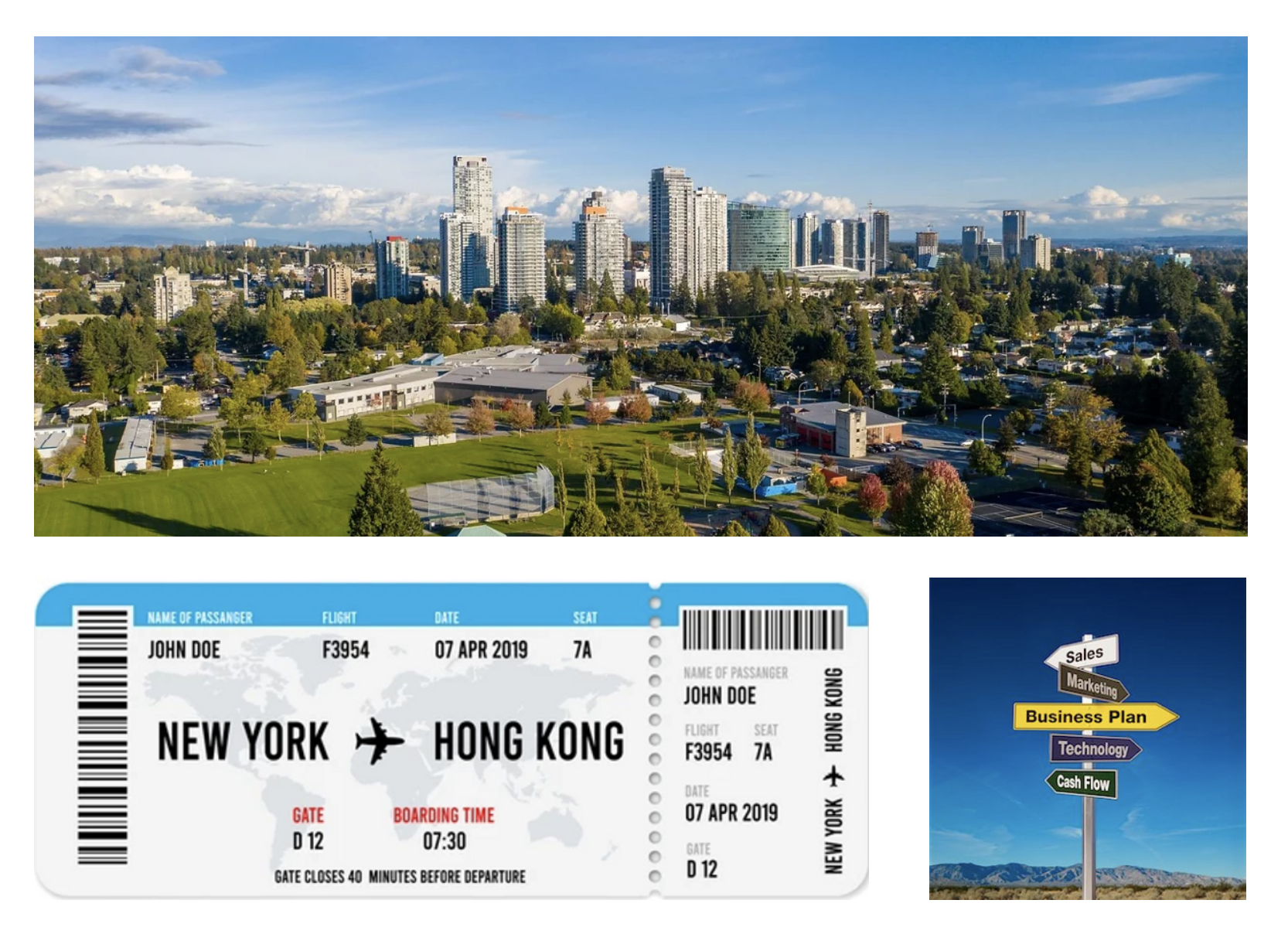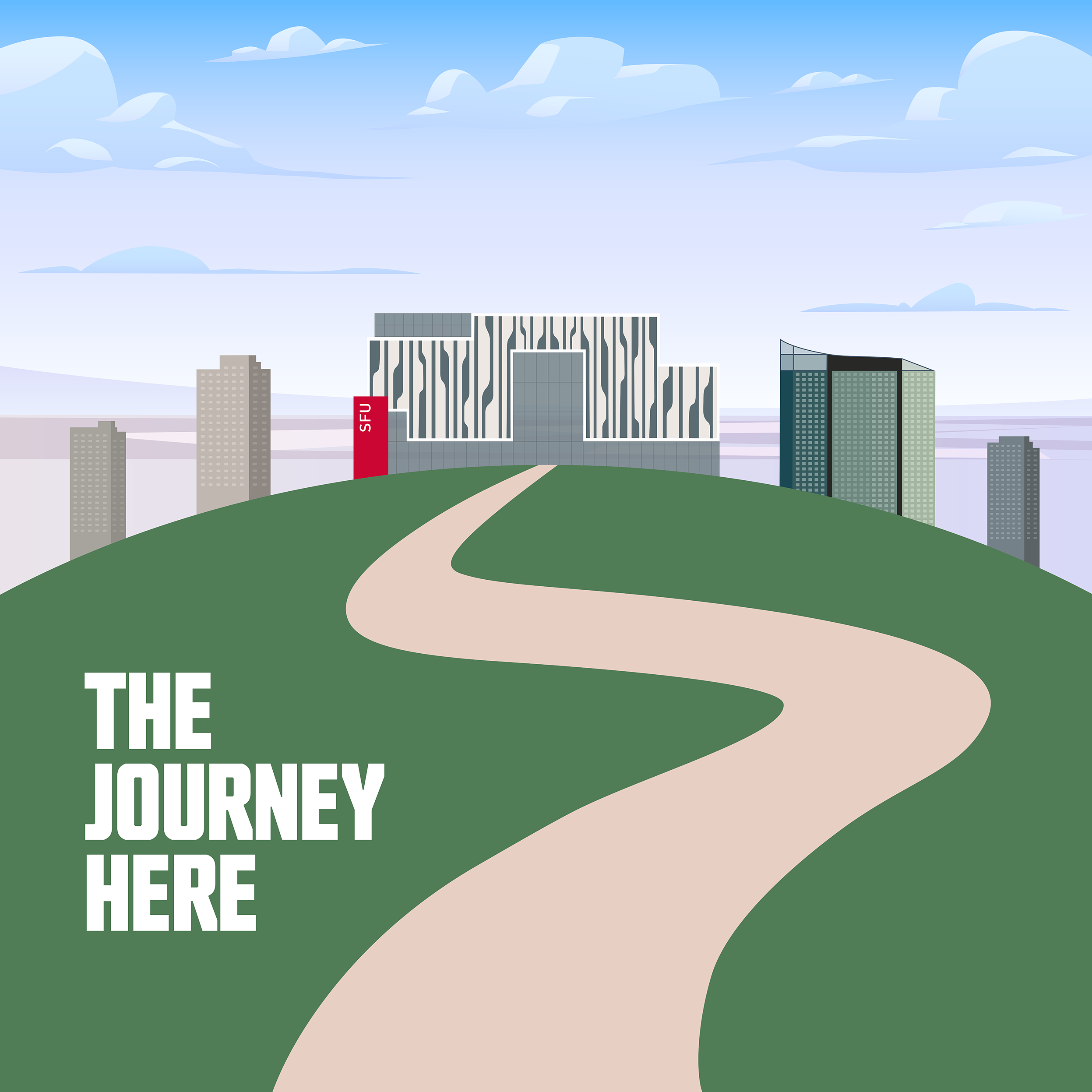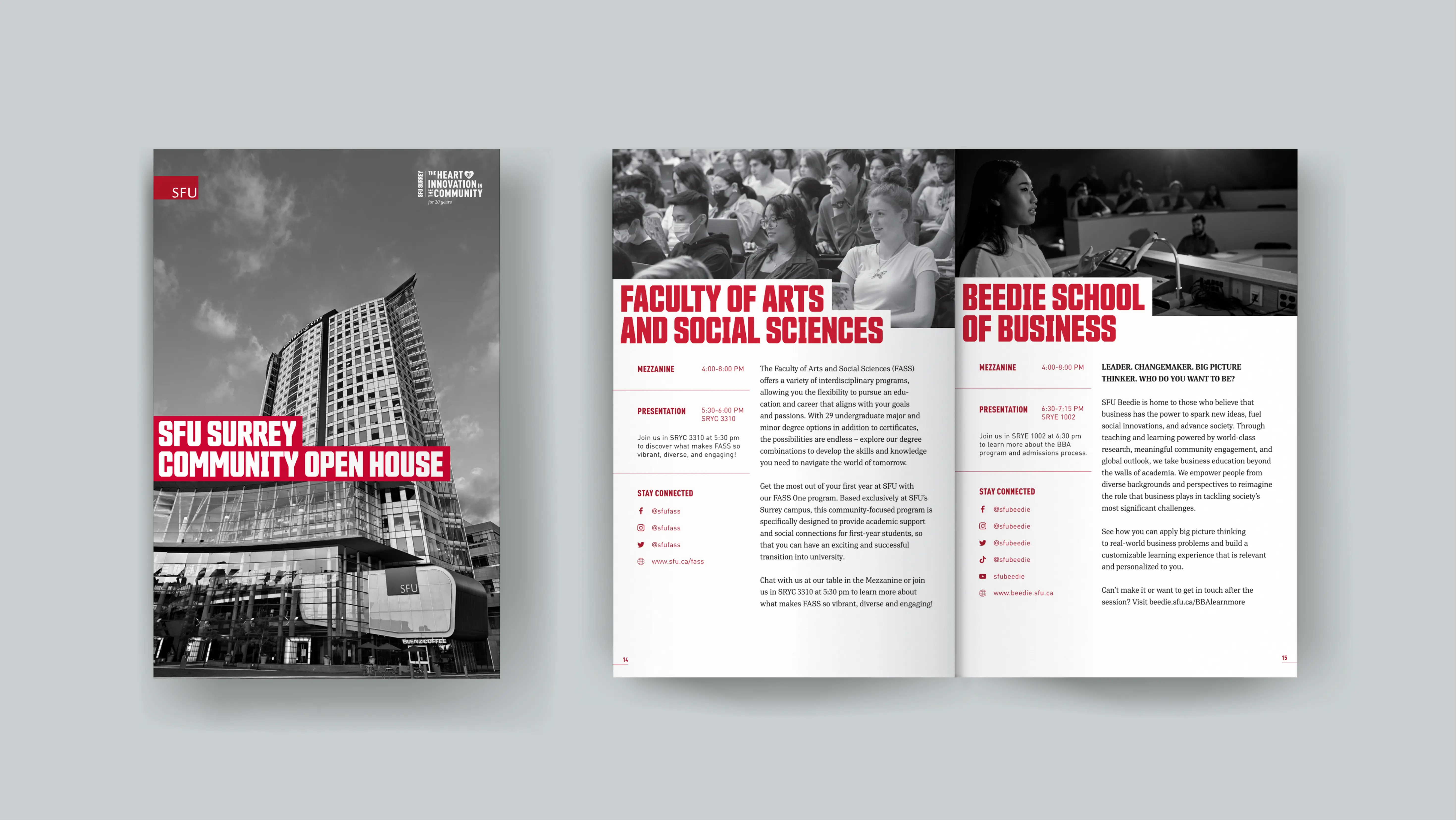The Journey Here
A podcast that profiles the stories of community builders from all walks of life, produced at SFU Surrey and hosted by SFU Surreyʼs Executive Director Steve Dooley.
Powered by RedCircle
OVERVIEW
Timeline
9 months (May 2021 - Feb 2022)
Team
Isabelle Louie, Rachel Wong
Toolkit
Audition, Illustrator, RedCircle, AEM
Role
As a Producer and Audio Engineer, I oversaw the pre-production, production, post-production, and launch of the podcast. This included establishing the vision and visual identity; researching, contacting, and scheduling guests; recording, mixing, and mastering episodes; and promoting the podcast through SFU's internal and external channels.
Deliverables
The final deliverables included nine podcast episodes featuring stories from SFU students, faculty, and community leaders.
Status
Live: The Journey Here is available on Spotify, Apple Podcasts, and Google Podcasts. Since the launch of season one, The Journey Here has reached over 600 listeners.
INTRODUCTION
Context
The Journey Here is a brand-new podcast produced at SFU Surrey and hosted by SFU Surreyʼs Executive Director, Steve Dooley. During my time as a Communications Specialist with the SFU Surrey Campus Administration team, I oversaw the pre-production, production, post-production, and launch of The Journey Here. As this was quite an extensive project, my responsibilities varied throughout each stage, with my main roles being the producer, audio engineer, and graphic designer.
PRE-PRODUCTION
Target Audience
Encompassing the greater community, beyond our campus.
During the initial planning stage, we discussed the purpose, intended audience, and vision for the podcast. We decided to expand our target audience to not only encompass our campus, but the community builders of Surrey as well, as SFUʼs Surrey campus has a unique identity at the intersection of university and community. Our vision for the podcast was to showcase the people in our community who have positively impacted the places we live, the university, and our society. With this established, we came up with a first draft of the podcast description.
Podcast Name and Refined Description
Choosing a name to convey our vision.
Based on this description, I brainstormed a list of podcast names before narrowing it down to three options: The Journey Here, Driving Us Forward, and The Path to Passion. We then sought feedback on these options in a survey, and the name that elicited the most positive feedback was The Journey Here. Using this name, I updated the podcast description and refined the language to better reflect our vision.
Initial Research
Compiling background information on guests and writing interview questions.
Once we had established the name, description, and purpose of our podcast, it was time to start talking to guests! In preparation for each interview, I researched our guests and compiled a biography on them to provide Steve with some background information. Additionally, I wrote interview questions and prompts for Steve to help guide their conversation. This work was split between Rachel and me, and I completed the research for five of our guests.
PRODUCTION
Pilot Episode
Testing the recording set up and other logistics.
Since we did not have a studio or the equipment to record interviews in person, we decided to host the interviews over Zoom. To test this setup, Steve recorded a trial episode with Nav Chima, Director, Community Programs & Partnerships at SFU Surrey. This episode was used to test the quality of Steveʼs microphone and also determined that wired headphones provided the best audio quality for guests. Additionally, we found that 30 minutes seemed to be the best length for our podcast format.
Recording Episodes
Briefing guests and recording episodes.
For the first season of The Journey Here, we had a diverse line-up of nine guests scheduled, which included students, faculty, staff, and community leaders. During recording sessions, I briefed guests about the recording process, then recording the interviews locally onto my computer, with each speakerʼs audio saved in a separate file.
POST-PRODUCTION
Editing the Conversation
Editing multi-track sessions in Adobe Audition.
Once the episodes had been recorded, I was responsible for editing six of the episodes. In my editing process, I used Adobe Audition to remove any stumbles, filler words, and long pauses. I marked short clips that could be used as a preview for the episode, took notes on what was discussed to create the show notes and episode description, and kept an ear out for any key phrases or themes that could be used for the episode title.
Assembling Episodes
Adding intros, outros, and music.
Once the conversation had been edited, I exported the multi-track session as a single track. Next, I constructed the episode by putting together the preview, music, intro/outro, and conversation all in one file. Once assembled, I reviewed the entire episode to ensure that the audio levels were consistent, then uploaded the finalized episode to a collaborative SFU Vault folder.
GRAPHICS
Ideation
Brainstorming the look and feel of the podcast.
I began this iterative design process by brainstorming words and gathering images that could be connected to our podcast name, The Journey Here. This included imagery of road signs, maps, paths, plane tickets, the SFU Surrey campus, and the Surrey Central skyline.
Sketching Concepts
Quick sketches of cover art concept ideas.
Based on the visual inspiration, I sketched some rough concepts and layout ideas. I brought these ideas to Rachel and Steve for their input, and we all liked the third sketch concept that showcased the downtown Surrey skyline in the background the best.
Designing the Cover Art
An iterative process using Illustrator.
FIRST ITERATION
Using Adobe Illustrator, I created a rough, digital representation of the third concept sketch. In this first draft, I used a stock image of a skyline to roughly visualize the layout of the cover art.
SECOND ITERATION
Next, I used the photo of the Surrey Central skyline from our brainstorming as a reference to create a vector illustration outlining the silhouettes of the most prominent buildings in downtown Surrey. In this iteration, I noted that the sky seemed to be overcast and the grass looked too dark.
THIRD ITERATION
As such, I lightened the sky and the grass, and added rounded clouds to make the art appear more friendly and welcoming. Reflecting on this iteration, I realized three things: the skyline looked very cluttered, the building colours appeared dull and uninteresting, and there was nothing that would make viewers immediately make a visual connection with SFU Surrey or Surrey Central.
FINAL ITERATION
With these three considerations in mind, I replaced the center buildings with an illustration of SFU Surreyʼs new building on University Drive. While creating the building outline, I recalled that we had recently unveiled a new 24-foot SFU sign outside this building; this provided a subtle and seamless way for me to incorporate the word “SFU” into the design itself. Next, I added more detail to the Central City tower to make it more recognizable and to strengthen the image of downtown Surrey. Finally, since I wanted to bring focus to these two prominent buildings, I reduced the number of high-rise buildings and added minimal details such as windows and shadows.
LAUNCH
Launch and Promotion
Distributing and promoting episodes through various channels.
We used RedCircle to host and distribute the podcast, and also set up a page on the SFU Surrey website where the show notes, guest biography, and links to each weekʼs episodes would be shared.
We officially launched our podcast on November 22, 2022, with new episodes released every Monday. I shared the news of the launch in our SFU Surrey weekly faculty and staff newsletter, the SFU Whatʼs On newsletter, and on our social media platforms.
WEBSITE
Podcast Website
Explore the show notes, listen to episodes, and more.
With the release of each episode every Monday, I updated the podcast website to reflect the most recent episodes and show notes.
REFLECTION
Final Thoughts
The first season of the podcast was a great success, reaching over 600 listeners. This project was a new and exciting experience for me, as this was my first time tackling a project of such magnitude. With such an extensive project, I was presented with numerous opportunities to take on new roles, gain new skills, and build upon my existing experiences.
In particular, this was a great opportunity to expand my skills in Adobe Illustrator and Adobe Audition, and I can certainly say that I have become much confident with these programs. Additionally, juggling this project with my other ongoing projects provided a fantastic opportunity to improve my time management, organization, and communication skills.
There were many times where I was faced with a task that I had never done before, such as creating a digital illustration for the podcast cover art, yet I was able to reflect on my previous experiences, learn from online resources, and draw from the expertise and feedback of my colleagues to support my work.
Reflecting on the process of creating a podcast from scratch and seeing it through from start to finish, I feel a great sense of gratification and pride in the work that I have put into this project. Overall, this has been an extremely valuable learning experience, and I am eager to carry forward the skills I have gained to my future endeavours.
